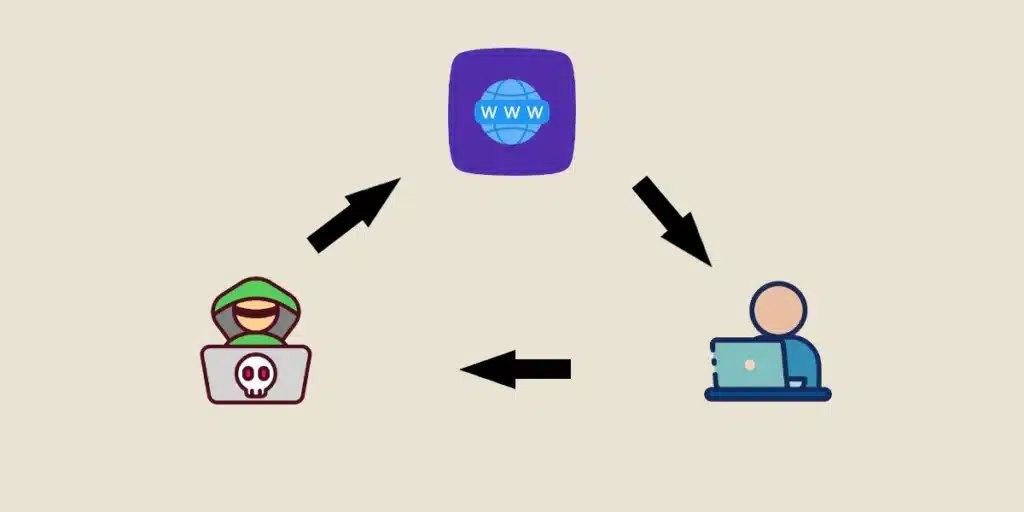An XSS (Cross-Site Scripting) cyberattack is accessible to all cybercriminals, yet it can have a catastrophic impact on the victims. To understand its potential effects and address it effectively, let’s explore its mechanisms and various forms!
At a time when the slightest vulnerability can expose millions of sensitive data, ensuring the security of web applications has become a top priority. Among the most common vulnerabilities, Cross-Site Scripting (XSS) is notable for its simplicity of execution and its destructive potential.
This type of attack allows a malicious actor to inject scripts into web pages accessible to users, potentially compromising their browsing experience, stealing personal data, or even their digital identity…
Origin and Basic Principle of XSS
Cross-Site Scripting (XSS) is a computer attack technique that involves injecting malicious code, typically in the form of JavaScript scripts, into web pages displayed to users. Unlike other types of attacks that directly target servers or databases, XSS exploits users’ trust in a vulnerable web application.
The term Cross-Site Scripting originates from early applications of this method, where attackers could inject scripts from an external domain, thereby enabling a “cross-site” execution across multiple sites.
Although technically inaccurate in some modern contexts, the acronym XSS was adopted to avoid confusion with CSS (Cascading Style Sheets). So, what is the attackers’ aim? Generally, it is to steal sensitive data, such as cookies or session information.
The goal can also be to take control of user accounts by exploiting active sessions, or to hijack the user experience by redirecting them to malicious sites. Hackers may also attempt to install malware on victims’ devices through scripts downloaded in the background.
Now that you know the basics of this type of cyberattack, let’s delve into the different forms these attacks can take to understand the specific nuances and dangers!

Different Types and Variants
Three main categories of XSS attacks can be identified, each exploiting specific vulnerabilities in web applications. Reflected XSS, or non-persistent XSS attacks, occur when a malicious script is injected via user input (such as a form or URL) and directly reflected in the server response without being stored.
For instance, a malicious user could send a URL containing a script within a parameter like “https://example.com/search?q=<script>alert(‘XSS’)</script>”.
If the site does not properly sanitize this input, the script will execute in the browsers of users clicking on this link. This type of attack can be used to steal cookies or redirect victims to malicious sites.
However, the second category, persistent XSS, is far more dangerous since the malicious script is stored on the server (for example, in a database) and executes every time a user loads the vulnerable page.
For example, an attacker might insert a script in a comment field on a website, causing the script to run in every user’s browser visiting this section.
An instance could be “<script>alert(‘Your account has been compromised’)</script>“. This method is often used to infect numerous users simultaneously.
The third type is DOM-Based XSS, where the malicious script does not pass through the server. Instead, it is directly injected into the browser’s DOM tree using JavaScript.
A malicious script can modify the DOM through an unfiltered user input, such as in the code “document.write(location.hash);”.
If a user loads a URL like “https://example.com/#<script>alert(‘XSS’)</script>”, the script will execute directly in the DOM.
More subtle than the other two attack types, this variant requires an in-depth understanding of JavaScript interactions.

Serious Consequences for Web Applications and Their Users
A website that succumbs to an XSS attack might lose its users’ trust, resulting in decreased traffic and damage to its reputation. With regulations like GDPR, a company failing to adequately protect its users can even be held accountable for attacks and face heavy fines.
Moreover, attackers can exploit XSS vulnerabilities to send spam or launch attacks against other users. For users, a consequence could be the theft of sensitive data. Malicious scripts can capture cookies, session information, or data entered in forms.
This information can then be used to seize control of accounts or commit fraud. Attacks may also exploit XSS to display fake user interfaces, prompting victims to willingly provide sensitive data.
Furthermore, some XSS scripts serve as an entry point for downloading and executing malware on users’ devices. To prevent such disasters, it is crucial to identify and rectify XSS vulnerabilities before they can be exploited.
How to Detect XSS Vulnerabilities?
Ensuring the security of web applications requires detecting XSS vulnerabilities as a vital step. Numerous methods and tools can achieve this. A common initial choice is to use automated security tools. For example, Burp Suite can identify XSS vulnerabilities through automated testing.
Similarly, the open-source tool OWASP ZAP aids in analyzing HTTP requests and identifying potential vulnerabilities. These solutions are quick to configure and efficient for covering a wide array of common cases.
Furthermore, a manual audit of user inputs is often necessary to identify complex vulnerabilities that automated tools might overlook. This process involves identifying all user inputs in the application (forms, URL parameters, search fields) and then injecting simple malicious scripts to test server responses and behaviors in dynamic pages generated by the client (DOM-Based XSS).

This method is advantageous for complex scenarios and allows a deep understanding of data flows. Another approach is conducting framework-based tests, such as those suggested by the OWASP Testing Guide. They provide comprehensive methodologies to detect XSS.
This includes tests for input and output validation and verification of security policies like Content Security Policies (CSP). Specific context tests can also be performed. For example, HTML encoding tests whether tags or special characters are correctly escaped.
JavaScript execution allows verification of whether user inputs can execute JavaScript. Meanwhile, DOM manipulations help identify potential client-side script injections.
Best Practices for Protection
Preventing XSS attacks involves establishing robust strategies to limit the opportunities for injecting malicious scripts. By leveraging specialized libraries like DOMPurify, one can filter out harmful data to sanitize user inputs. Any unexpected content or non-compliant content can be rejected.
Server-side and client-side validation ensures data compliance upon receipt and avoids relying solely on client-side controls, which can be bypassed. Another technique involves encoding sensitive data. Special characters can be converted into HTML or JavaScript entities, preventing them from being interpreted as executable code.
Implementing a Content Security Policy (CSP) is also crucial. This involves defining strict rules for loading content, such as allowing scripts only from trusted sources or blocking the execution of inline or unauthorized scripts.
Using modern frameworks with built-in protection can also prevent certain injections if best practices are followed. Examples include Angular, React, and Vue.js. However, the most important factor remains educating developers. They must understand the XSS risks and adopt secure coding practices.

Several notorious examples of XSS attacks illustrate the destructive potential of these vulnerabilities. In 2011, an XSS attack targeted Facebook users through a link shared in private messages.
When users clicked on the link, a malicious script would execute and automatically post the same link on the infected user’s wall, resulting in a rapid viral spread that affected millions and caused many to lose trust in the platform.
The Worst XSS Attacks in History
Similarly, in 2017, an XSS vulnerability was found in a popular WordPress plug-in. Attackers could inject scripts into comment fields, affecting all users visiting the compromised page.
Hackers thereby stole user data and took control of several websites. Thousands of sites had to immediately update their plug-ins. Even today, many XSS vulnerabilities continue to be detected.
The CISA recently reported on the exploitation of a 5-year-old flaw in jQuery, and malicious actors also took advantage of a vulnerability in the Roundcube Webmail client. During the elections in Romania, the electoral infrastructure faced over 85,000 cyberattacks, some of which exploited XSS vulnerabilities…
Conclusion: XSS, a Major Threat to Web Applications
Cross-Site Scripting remains a major threat in the cybersecurity landscape, affecting both small applications and renowned platforms.

The diversity of attacks—whether Reflected, Stored, or DOM-Based—demonstrates the ingenuity of attackers and underscores the urgency for developers and companies to take preventive measures.
As recent news highlights, even well-established technologies like jQuery can be exploited if not regularly updated. This emphasizes a critical need: integrating security from the early development stages, raising team awareness, and relying on modern tools to detect and remediate vulnerabilities before they are exploited.
To learn how to effectively thwart XSS attacks, you can choose DataScientest. Our training courses will equip you with all the skills required to become an analyst, administrator, consultant, or cybersecurity engineer.
Additionally, we also offer DevOps or Software Engineer courses that will teach you to develop highly secure web applications protected against Cross-Site Scripting!
All our training programs are conducted remotely through BootCamps, alternance, or continuously, enabling you to receive a diploma and certification. Our organization is also eligible for funding through CPF or France Travail. Discover DataScientest!
You now know everything about XSS attacks. For more information on related topics, check out our article on phishing and our article on the different types of cyberattacks!










